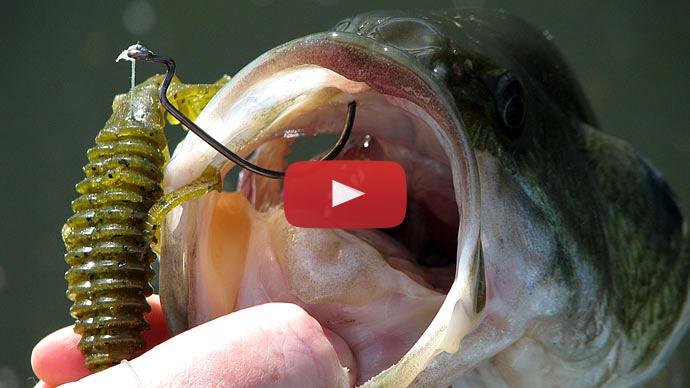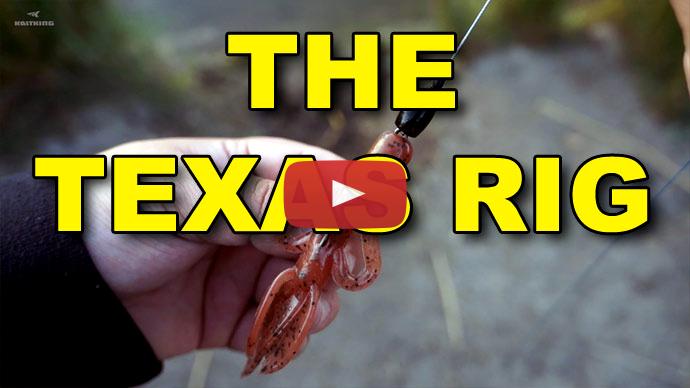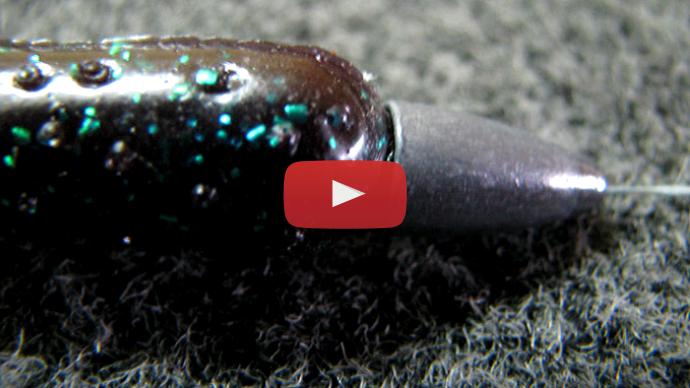Keri May: The next three tips are going to be about Texas-Rigging.
Ott DeFoe: Texas-Rigging. The first thing that comes to mind is to match the hook to the bait, you know, to make sure you're using the right size and the right kinda hook. You know, whether you need a wide gap or a standard worm hook or a straight shank hook. I carry all three and I use all three. So, you know, just different situations, different plastics. Don't have time to go through all that right now, but make sure you research it and see which hook fits which bait best.
Next would be if I'm Texas-Rigging, I'd kinda consider that a little bit of a finesse technique, most of the time, so I'm gonna use as light a weight as possible where with a jig, sometimes I'll go heavier and try to get more of a reaction. With a Texas Rig, I'm typically gonna go light because I want something a little more natural and that's what I'm gonna do with the Texas Rig.
Number three, would be, again, on your colors, you know? Keep it simple. We travel all across the country and I catch bass on say, a Bass Pro River Bug. I carry about five or six colors. I use three of them a lot.
Keri May: Keep it simple.
Ott DeFoe: Right. You don't need a whole bunch of different colors to catch bass anywhere you go.
Brandon Palaniuk: I would say the same thing applies with that, a lot of it, as the jig fishing, right? It's a technique that you can fish in a lot of different situations, a lot of different scenarios, and a lot of different baits, right? So, the first thing would be choosing the right bait for the situation because you can take a Texas Rig, you can put a 10-inch Zoom Ol' Monster worm on it, you can throw a little tiny Flippin' bait on it. So, I would say choosing the right bait for those situations and then, I would say a lot of it's the same. Choosing the right weight size, right? If I'm fishing up shallow, a lot of times it'll be a little bit lighter. If you go offshore, it gets windy like it is today...
Keri May: Like it is today, yeah.
Brandon Palaniuk: ...you wanna keep it down a little bit, so go with a little bit heavier weight. Then also, a lot of it is choosing the right hook, adapting that to the bait, you know? If I'm flipping, a lot of times I'll go with a straight shank flipping hook. But when I move offshore, I like to go with a worm-style hook or something that's maybe a little bit longer and has an offset shank bend to it.
Jacob Wheeler: Texas Rigs, okay. I'll tell you what, I've caught a few bass on Texas Rigs in my day and Texas Rigs definitely will play no matter where you're at. But my favorite thing with Texas Rig, no doubt, is a 10-inch worm in the summertime. Throwing it around brush piles, it's something that absolutely catches them. But for me, when I'm Texas-Rigging a big worm out deep, I like to actually make sure my weight is not pegged. And the reason for that is when I bring that over that brush pile, that weight almost free-falls weightless, and so I feel I get a few more bites. So, if you're fishing brush or fishing around a lot of cover a little bit offshore, stop pegging your weight. You might get a few more bites.
Also, when I'm fishing a bait that I'm flipping that is a glide bait, almost sorta like those beaver-style baits, you know, a Biffle Bug without the legs on it. Anything that glides, I do not peg my weight and the reason for that is because you want your bait to glide a lot more, you don't peg it. Or a tube is a great example. If you're Texas-Rigging a tube, it'll glide a lot more if you don't peg your baits to, you know, have appendages on them. So, your more cross-style baits, like a hammer cross, something like that, peg those. So those are the three things that I would recommend. Definitely works for me.
Edwin Evers: Texas-Rigging, number one tip is make sure your worm is straight. I see so many people that do not line that worm up with the seam. You know, there's a seam where that mold closes. Make sure your worm's straight. You know, I really prefer a round bend hook. You just have the best...the best hooking percentage would be my second tip, you know, like a good Mustad Round Bend Hook. And then third, the fall rate, you know, I would just think about what size weight you're gonna use, you know? The lighter the weight, the slower it's gonna make you work that bait. The heavier the weight, the faster you can work it. So, experiment with different size worm weights. See if it changes the amount of bites you get.
Greg Hackney: Number one, for me, on a Texas Rig is I'm 100% of the time pegging my weight, and the deal is that way, I'll always know where my bait is. The only drawback to not pegging it, a lot of times what'll happen is, especially like if you're using a creature bait or something with legs, that bait will get caught on something and the weight will pull away from it and you've about wasted the cast because the bait didn't go where you wanted it to. And so, if I want the bait to fall slow, I'll just use an extra small weight. But 100% of the time, I always peg my weight.
Number two would be I always use a rubber insert. I do not use a bobber stop. I use the rubber insert and the reason for that, it protects my line from tungsten weights. You know, one thing that's different, a lot of guys now have switched over to using tungsten weights instead of lead and those weights are extremely hard and they have hard edges and then I find they're a lot harder on your line, regardless if you're using braid or you're using fluorocarbon. So, I always use the rubber peg. The other deal is have a good selection of rubber pegs because not all weights have the same line hole and so, typically, the bigger the weight, the bigger the hole. So, there are pegs made for the bigger weights.
Keri May: Oh, great tips. Great tips.
Skeet Reese: Yes, I fish a straight shank hook on all my soft plastics, so it's a Trokar TK180. A straight shank hook will give you a much better hook and land ratio on any Texas Rig bait, period. It doesn't have the flex in it as an offset hook. Then, typically, fish the lightest possible sinker you can fish to get away with. You'll get more bites typically with a lighter weight than you will a heavier weight. And then, third goes back to fishing fluorocarbon lines. So, for me, it's Trilene. That'll help you get more bites.
Brent Ehrler: Top three tricks or tips.
Keri May: Could be tricks too.
Brent Ehrler: Tricks, tips. You know, let's go bait choices. Number one, for me, is actually a Yamamoto Senko. Texas-Rig it, you're weightless. The other thing I will do is put a 1/8-ounce Eagle Claw tungsten weight on there and it has a unique fall to it. I peg that always and it has a unique fall to it and if I'm in trouble anywhere, that's a bait that I know will catch fish. If I don't know anything about the lake, I know I can tie that on and catch fish. And then, the Flappin' Hog, which is just a beaver-style bait, very subtle. You can flip with it, you can pitch with it, you can cast with it, you can do everything with it. They have a brand new bait out called the Cowboy, which I have just started to use, and I think that that's gonna be, you know, something that's gonna come into play big time for me in the future. It's literally brand new. I got them about five days ago. It's that new. So, that's something that will probably come into the mix here pretty quick. So, bait choices for me. Senko, Flappin' Hog, and Cowboy, and that's it.
Keri May: That's it?
Brent Ehrler: You don't need anything else.
Keri May: Simple. I like it. I like it a lot.



